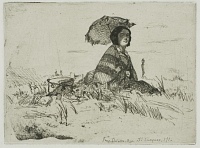Etchings Institutions search term: freer gallery
En Plein Soleil | ||
| Number: | 11 | |
| Date: | 1858 | |
| Medium: | etching | |
| Size: | 101 x 136 mm | |
| Signed: | 'Whistler' upside-down at upper left; 'Whistler.' at lower left | |
| Inscribed: | 'Imp. Delatre. Rue St. Jacques. 171.' at lower right (3) | |
| Set/Publication: | 'French Set', 1858 | |
| No. of States: | 3 | |
| Known impressions: | 44 | |
| Catalogues: | K.15; M.12; T.4; W.6 | |
| Impressions taken from this plate (44) | ||
KEYWORD
TITLE
'En Plein Soleil' (1858, Whistler). 2
'Le Parasol' (1874, Flemish Gallery). 3
'En Plein Soleil' (1874, Ralph Thomas, Jr (1840-1876)). 4
In fact, all Whistler's cataloguers followed the original published title, and called it 'En Plein Soleil', which means, literally, in full sun.
The phrase implies an activity pursued in the open, on a sunny day. It could be a shared activity, such as a picnic, or an activity pursued by the artist alone, in making an etching. The title echoes the idea of working 'en plein air', as pursued by the Barbizon painters. They drew and painted directly from nature rather than completing their work in the studio.
However, with an etching, only the first stage of drawing on the copper plate could be done in the open: the etching and printing process required a return to the studio or to a printing house. Likewise, revisions could be made on site but completed in the studio. Thus although the etcher worked 'en plein air', the printer, who was not necessarily the same person, had to complete the process in the studio. At this time etchers who worked 'en plein air' like Charles Jacque (1813-1894), and Whistler, had their plates printed and published by Auguste Delâtre (1822-1907), back in Paris.
2: Douze eaux-fortes d'après Nature (the 'French Set').
3: London Pall Mall 1874 (cat. no. 44).
4: Thomas 1874 (cat. no. 4).
DESCRIPTION
SITTER
5: Lochnan 1984 , pp. 28-9, 31.
SITE
DISCUSSION
The Goncourts commented in their journal on 12 November 1861: 'The future of modern art, will it not lie in a combination of Gavarni and Rembrandt, the reality of man and his costume transfigured by the magic of shadows and light, by the sun, a poetry of colours which fall from the hand of the painter?' 6
In some ways, despite its lack of colour, the etching presages the vivid brightness of such Impressionist works as Monet's La Promenade, la femme à l'ombrelle of 1875. 7
Some years later, in 1881, Jacques Joseph Tissot (1836-1902) made an etching with the same title as Whistler's, En plein soleil. It shows a very well-dressed, even over-dressed, middle class family on a hot summer's day: Kathleen Newton and another woman with two small girls, a boy and a black cat on a lawn, surrounded by luxuries - a sheepskin, cushions, parasols, a book and toys. The careful delineation of grass and flowers and frilly silk dresses is considerably more detailed than Whistler's. 8
6: Translated, Tinterow & Loyrette, Origins of Impressionism, exh. cat., Paris & New York, 1994-95, p. 132.
7: National Gallery of Art, Washington DC, 1983.1.29. Daniel Wildenstein, Claude Monet. Biographie et catalogue raisonné, Paris 1974 (cat. no. 381).
8: M.J. Wentworth, M. Justin, James Tissot: Catalogue Raisonné of his Prints, Minneapolis Institute of Arts, 1978 (cat. no. 54); Tissot's painting of the same subject is in the Metropolitan Museum of Art (2006.278).
